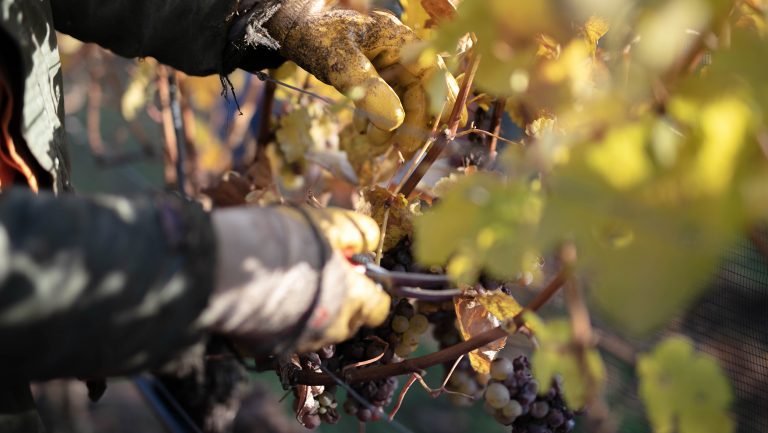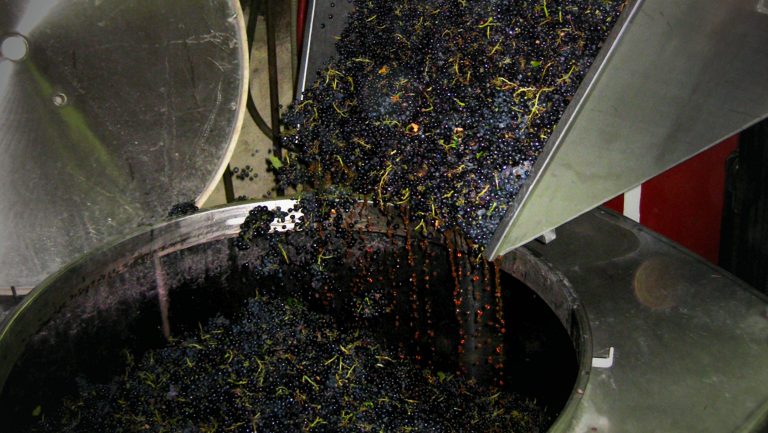Any fruit or vegetable is, under the wrong conditions, subject to rot, often in the form of an infection from Botrytis cinerea. The fungus is found from the tundra to the tropics, thriving in areas with ample humidity—at least 80 percent—and temperatures between 12 and 25 degrees Celsius. Most farmers view it as a pathogen, but winegrowers, in the right conditions, see it as pure gold. Sauternes, Tokaji, and other botrytis-affected wines are among the world’s most treasured libations, and science is just beginning to understand how botrytis creates these luscious wines, which have earned the fungi the nickname “noble rot.”
Noble rot, as opposed to undesirable bunch rot or gray rot, only occurs under specific conditions. “For producing botrytis, the east side of the Neusiedlersee was always better than the western side,” says Gerhard Kracher, the third-generation owner of Weinlaubenhof Kracher in Austria, who produces a range of wines that rely on botrytised grapes. Lake Neusiedl, the largest natural lake in Central Europe, and numerous smaller lakes nearby provide moisture. “There’s always fog in the morning hours,” says Kracher, “but there is always some wind coming in during the day, blowing out the fog. So it’s the combination of wetness and then dryness, with the sunshine coming through, that’s the perfect climate for botrytis to grow.”
The fine line between beneficial noble rot and devastating gray rot has prompted researchers to investigate how the noble version occurs, how exactly it affects the grapes, and how it contributes to such captivating finished wines.

Don’t miss the latest drinks industry news and insights. Sign up for our award-winning newsletters and get insider intel, resources, and trends delivered to your inbox every week.
How Grapes Respond to Botrytis
According to Dario Cantù, Ph.D, a professor of viticulture and enology at UC Davis, the wet-to-dry conditions that Kracher describes give the grapes a chance to resist the invading fungus.
In 2015, Dr. Cantù conducted a study in partnership with Dolce, Far Niente’s Napa Valley project focused on noble rot wines. “What we saw is that the slowing down of the infection during the day allowed the fruit to respond, metabolically, to the infection. This is very different from what happens with bunch rot, where the infection goes so fast that the plants don’t have a chance to readjust their metabolism.” Bunch rot renders the grapes unusable. Most producers of noble rot wines will go through the vineyard and remove any berries or bunches with gray rot; if they are included in the wine, they can lend an unpleasantly strong mushroom or earthy aroma.
Cantù says the berries’ stress response to botrytis is very similar to its response to a drought, which makes sense as the grapes are losing water during both events. When the fungus invades, it breaks down the cells of the grapeskin, and with enough warmth, the grape’s water can evaporate through it. The berries desiccate, losing up to 60 percent of their weight. The fungus also consumes a large amount of sugar and some acids as well, but what remains is so concentrated that the pressed juice can contain between 350 to 450 grams per liter of sugar.

How Cellar Climate Impacts Barrel-Aged Wine
Cooler temperatures and higher humidity in barrel-aging rooms can create fresher, cleaner wines, but the impact of a warming climate poses challenges to these ideal conditions
Botrytis consumes tartaric acid more than malic or citric acid. “During the two weeks of Aszú formation [botrytis-induced grape shriveling], the chemical composition of the berry is changing,” says Robert Kindl, the general manager at Tokaj-Oremus in Hungary. “In the case of Furmint, the ratio between tartaric and malic acid is 2:1 in the healthy berry and changes to 1:3 in the shriveled berry. The amount of citric acid is increasing as well, and the fungi forms glycerol. The increasing acidity is the key for the balance of the Tokaji Aszú wines and the glycerol increases the complexity and the mouthfeel.”
As the berries shrivel, they take on a violet color. This, according to Cantù, is not the color of the botrytis, but a reaction within the grape. “White grapes are white because of a mutation; they cannot accumulate metabolites called anthocyanins, the compounds that confer the red coloration,” he says. “However, during infection by botrytis, we have seen that those compounds actually accumulate. It’s amazing. The clusters turn from white to pink. For a long time that pink was thought to be an oxidation process, but when we measured anthocyanin in those berries, there were levels of anthocyanin not expected in white fruit.” How and why white grapes accumulate anthocyanins during a botrytis infection has yet to be discovered.
How Botrytis Affects Wine Flavor
Botrytis also affects the flavor profile of noble rot wines. It creates a complexity and intensity of aromas that distinguishes them from other sweet wines, and that goes beyond the simple concentration of aromatic compounds that come with desiccation. “The impact of botrytis on the fruit’s production of aromatic precursors is 100 or 200-fold,” says Philippe Darriett, a professor of enology at the University of Bordeaux. “It’s extraordinary.”
According to Darriett’s research, the aromatic impact of botrytis manifests in the grape through two mechanisms. First, for citrus notes such as lemon and grapefruit, the fungi induces the concentration of aromatic precursors already present in the berry that will be transformed into those aromatic compounds during fermentation. Second, the compounds responsible for stone fruit aromas such as apricot and peach are created directly within the berry as it reacts metabolically to the fungal attack. Other notes often associated with noble rot wines, such as honey, seem to derive entirely from the botrytis itself rather than through a concentration or modification of the grape’s aromas.

Because botrytis breaks down the skins, tannins are also extracted during pressing; however, they are rarely felt in the finished wine. “Botrytis oxidizes the tannins in the berry,” explains Darriett, “so when you are pressing the juice, the tannins are much less impactful than when pressing clean grapes.” This means the must can be pressed quite firmly without extracting tannins or bitter flavors. Kracher, for example, says he typically uses up to 2.2 bars of pressure. “Normal presses go up to 1.5 or 1.8 bars,” he says, “but for great [dry] wines you’d never go that high.”
The tannins still pay off as the wine ages in the bottle, even if they’re not part of the flavor profile. “We work a lot on the chemistry of aging, especially on the aromatics,” says Darriett. “Due to the limitation of the tannins in these wines, the oxidative phenomena—and particularly oxidative phenomena that contribute to the diminution of aromatic freshness—are much less important.” In other words, aside from giving Sauternes, Tokaji, Alsatian Selection des Grains Nobles, and Germany’s Trockenbeerenauslese wines a flavor profile and sweetness level that stands out in the world of wine, botrytis also makes sure that these are wines for the ages.

Dispatch
Sign up for our award-winning newsletter
Don’t miss the latest drinks industry news and insights—delivered to your inbox every week.
Jim Clarke writes about wine, beer, and spirits for trade and consumer publications, including Beverage Media, Fortune, and World of Fine Wine. He is a sommelier and the U.S. marketing manager for Wines of South Africa.







